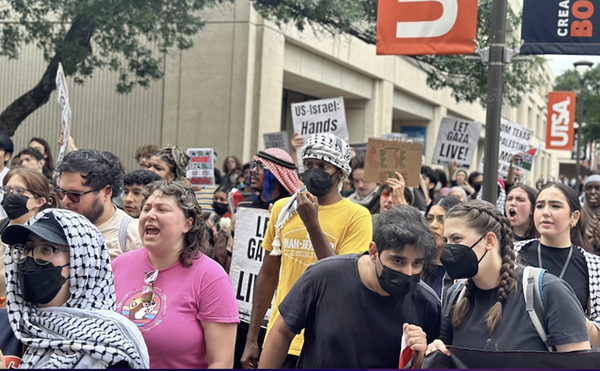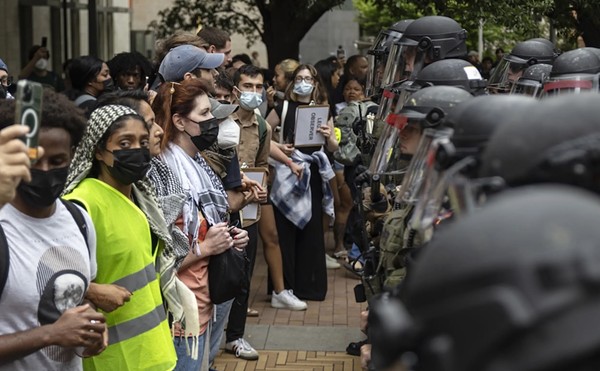Oversight, we imagine, is one of the qualities that differentiates our modern western justice system from the bad guys and dank, dark history. Even after we’re arrested, we have rights: We can’t be starved, beaten, forced to incriminate ourselves, or (theoretically) waterboarded. And if our jailers break the rules, we have recourse to someone, somewhere. This is supposed to be no less true at our small, local booking shops than at our federal penitentiaries. But for a two-year period beginning in August 2006, complaints about the treatment of detainees at the Frank D. Wing detention facility, Bexar County’s one-stop arrest-to-bond shop, fell into a black hole created by City Manager Sheryl Sculley’s decision to overhaul the Office of Municipal Integrity.
As the Current reported earlier this year, nine months after she joined the City, Sculley created the Municipal Integrity Committee — staffed at the time by Deputy City Manager Pat DiGiovanni, Human Resources Director Edward Belmares, City Attorney Michael Bernard, and a representative of Police Chief William McManus — that essentially replaced the director’s position at OMI. The committee reviewed every complaint sent to the office, and began to route many of them back to the departments where they originated on the theory that they were personnel-management issues, not technical cases of “fraud, waste, or abuse.” According to DiGiovanni, the committee’s job is to make sure that OMI investigates only complaints that fit that narrow directive. The effect is to put City departments largely in charge of policing themselves. `See “Toothless watchdog,” July 15, 2009.`
In the case of the detention center, when Sculley’s committee took over, at least five open case files were sent from OMI to the Municipal Court that oversees the jail facility. The City Manager’s office claims the Court took responsibility for investigating the claims; the Court says it asked the City Manager’s office more than once to send the complaints to the police department or another entity better-suited to criminal investigation. The result of the stalemate was that most of the complaints — which included allegations of stolen personal belongings, a fractured knee, and several instances of physical abuse — languished until last fall, when the City and the Court finally asked the police department’s Internal Affairs to take them over. What finally made the City do the right thing? An Express-News story that never saw the light of day.
ghost story
In September 2008, HR Director and OMI Committee member Belmares sent a memo formalizing an agreement in which SAPD Internal Affairs would assume responsibility for existing and future municipal-court complaints involving theft, excessive use of force, or otherwise “of a criminal nature.” According to Belmares and Norma Morales-Arias, the Municipal Court administrator, discussions about what to do with the open OMI cases had been going on for a while, but interviews with individuals involved in the decision, former and current Express-News staff, and a paper trail of open-records requests suggest there was an outside catalyst for finally cleaning up the mess created by the OMI shakeup.
Beginning in May 2008, Express-News reporter Todd Bensman, hot on the trail of the playground-inspection scandal that the paper would break in early June, began requesting OMI case files. As the Current learned from our OMI research, the OMI files dating from fall ’06 raise serious questions about the Municipal Integrity Committee’s process and follow-through. A thick file with detailed allegations that Public Works ignored federal flood law in approving a dam, for instance, was referred to former Deputy City Manager Jelynne Burley, along with a thick packet of related documents. A month later the OMI director emailed Burley to inquire how the investigation was proceeding; no response is documented, but a February ’07 note on the file cover reads “Close per OMI meeting.” A subsequent complaint from spring 2007 about Public Works’ handling of water-surface-elevation issues in the River Walk’s Museum Reach is also forwarded to “management,” with a memo from Belmares to Burley saying that it doesn’t require “internal investigation.” What came of these concerns? Were they evaluated, and addressed if they were substantiated? And, of course, there are the jail-abuse cases, which were still listed as “open” in OMI’s system this fall, two years after they were referred to the Municipal Court.
Former San Antonio City Auditor Pete Gonzales, a key source in the playground story whose abrupt termination* helped expose the City’s coverup, says Bensman also interviewed him about the changes that Sculley implemented at OMI.
“`Bensman` had interviewed me to the extent that I knew about the Municipal Integrity Committee,” said Gonzales, who calls the current OMI structure “a huge conflict of interest.”
According to DiGiovanni, Bensman met with him and the City Manager, too: “We sat with Todd and reviewed the whole OMI process that we used.” Morales-Arias and Court Clerk Fred Garcia also recall meeting with Bensman that summer or early fall. “He raised a lot of the same concerns you have,” Morales-Arias told the Current. “But then nothing came from that. I don’t know what happened.”
Gonzales says he knows: “`Bensman’s` own people shut him down from above. He found a lot of good information, and they made him stop.” Gonzales’s account is seconded by former and current Express-News editorial staff, who spoke on condition of anonymity. Although Bensman’s playground story was an immediate sensation, and resulted in the resignation of Parks and Recreation Director Malcolm Matthews, Express-News Editor Bob Rivard was angry that Bensman didn’t give City Manager Sculley a chance to respond to the playground story before it went to print. Rivard, who called the omission “unprofessional” in an interview with the Current, issued a public apology to Sculley in his June 14, 2008, column.
Following the playground story, sources say Rivard made it known that he needed to approve open-records requests before they were sent to City Hall; the word in the newsroom was that Sculley had characterized them as “fishing expeditions” and complained about the manpower and expense required to fill them. Although one source indicates Rivard never followed through on that threat, the fallout had a chilling effect, reporters say. But Bensman apparently contined to pursue his OMI story, submitting open-records requests on June 24 and August 15, and confronting Garcia, Morales-Arias, and Municipal Court Presiding Judge John Bull with a stack of unresolved OMI jail-abuse files. Judging by the open-records request timeline, Bensman worked on the story over the course of at least three months, but in the end it came to nothing.
“They were very artful in what they did,” says one former writer. “They let it die on the vine.”
Another source says Bensman was finally told directly that Rivard didn’t want the story. But if accounts of how the OMI exposé was killed vary, the impression among Express-News sources the Current spoke with were consistent: “It seemed like Todd got yanked off the story because Sculley was complaining,” said one observer.
Bensman took a buyout and left the Express-News late this summer after racking up numerous state and regional journalism awards and his second National Press Club honor. Contacted via his website (toddbensman.com), he confirmed that he was working on a story in mid-2008 about the lack of oversight in Sculley’s OMI, but he declined to comment on why the story never ran.
“Not one of the many city government ethicists I interviewed around the country, or the four former San Antonio city managers I spoke to, believed that Sheryl Sculley’s new model of direct intervention in Municipal Integrity Office investigations was the norm or even close to a good idea,” he wrote in an email. “I would have quoted them.”
Rivard, on the other hand, insists there never was a story. “I’m not saying Todd didn’t want to do a story,” he said, “but there was no story spiked.” Rivard says he was aware of one of Bensman’s sources, and “We didn’t consider her reliable.”
“We’ve gone down a lot of blind alleys,” Rivard added. “But you don’t read about them in the paper.”
Rivard claims he didn’t know that Bensman’s story went beyond a single source and encompassed the Municipal Court detention center. “He never once brought that up to me,” he said. “And Todd had an open door into my office.” He calls the allegation that he told the newsroom that he had to sign off
on open-records requests “nonsense.” Athough, he added, “Todd had a reputation among editors for wallpapering institutions with record requests.” This writer, no slouch when it comes to OR, wonders how many requests might add up to “wallpaper”: Express-News reporters had made at least 41 open-records requests just to the City through November 10 this year.
It’s only fair to note that some of those requests, including a July 27, 2009, query for all digital and electronic communication between Sculley and City PR Director Di Galvan, followed an unflattering Express-News report that the City — and specifically Sculley and McManus — had ignored warnings from the Texas Department of Insurance about the aging Kiddie Park’s troubling safety record. (N.B. The City Manager was not quoted in that story, either.) And this fall, the Express-News hired the Current reporter who wrote our July OMI story.
“They can go where they want,” Rivard said of his City Hall reporters.
more than a squeaky wheel
So, how good was this potential story?
A year after Sculley’s committee took over the Municipal Integrity office, the department’s director position was eliminated (the chief investigator is now a member of the committee), but for the final year she worked at OMI, Director Virginia Quinn was required to report potential investigations to the committee, which, she told the Current, determined which complaints would be pursued, and how.
“My investigations were channeled, controlled,” Quinn said. “Sometimes, for example, if I’d bring a complaint, I would be instructed to give the complaint back to the director of the department from which it came, and say, ‘Here, you take care of it.’ To me, that sort of defeats the purpose.”
Sometimes those complaints involved fairly petty HR issues — whether someone brought their child to work, used a City vehicle on a personal errand, or was rude on the phone — other times they were much more serious: lewd behavior, drug use, allegations that an individual who handled loan applications for the city was cutting her real-estate-agent son in on deals. In the case of the detention center, the allegations were almost always criminal in nature: theft and physical abuse. Prior to Sculley’s reorganization of the department, OMI would investigate the jail-abuse allegations and forward its findings to the City Manager’s office, the Court, and sometimes SAPD for followup. OMI operated with a small staff — Quinn, two civil investigators, a police officer, and a secretary — but it covered a lot of territory.
In January 2001, a woman who was held at the San Antonio detention center complained that she was sexually harrassed by a sergeant, who later gave her a ride home. Quinn’s office interviewed the individuals involved, and when the stories conflicted, went as far as administering polygraph tests that “indicated that `the sergeant` showed deception on each of four relevant questions.” A memo sent in March of that year to the Municipal Court and the City Manager’s office concluded “the totality of circumstances and facts in evidence examined during the course of the investigation generally support a finding of misconduct on behalf of `the sergeant`” serious enough to warrant suspension, removal, or demotion. The memo also recommended that the detention center adopt a policy forbidding “fraternization with prisoners.”
In August 2005, a female arrestee complained that a detention officer repeatedly slammed her head into the wall of the isolation cell where she was placed. OMI’s investigators used a combination of video-surveillance tapes from the center, interviews with detention-center guards, and interviews with two other prisoners held in the facility that night — one of whom, they confirmed, was injured by the same officer in a similar manner — to determine that the allegations were founded. OMI also discovered that the jail supervisor on duty during the incident instructed the officer involved not to write the required “use of force” report. A March 13, 2006, memo from Quinn to Sculley and Bernard notes that the case was forwarded to the SAPD for further investigation and requests a report on “any actions taken by your department relative to this investigation.”
off the books
But in the fall of 2006, the system began to get muddy. On October 3 of that year, Quinn wrote to John Bull, Municipal Court Presiding Judge:
“I am following up with you concerning the complaint from `a woman` that was referred to you on August 22, in reference to her claim of inadequate medical attention to a wound on her foot. Per the Municipal Integrity Committee, this matter was referred to you for follow-up.”
The Judge replied that his office had been seeking additional information from OMI, and then instructed Quinn to deal directly with Morales-Arias “on all these types of matters in the future.”
On October 20, another woman filed a complaint with OMI, claiming that detention-center guards fractured her knee, prompting Quinn to email DiGiovanni and ask “ ... should we refer these complaints directly to Norma and her staff, per the instructions from Judge Bull?”
“Let me talk with the Judge,” DiGiovanni replied. “I have a lunch coming up with him soon.”
Finally, a handwritten November 27 note from Quinn reads: “Met with OMI committee. Pat DiGiovanni said he never had the lunch meeting. Instructed me to gather all cases together and he said he would sit down with the judge and discuss them.”
From this point on, it appears new jail-abuse complaints filed with OMI were redirected to the Municipal Court, and at least five open cases were shipped from OMI to Judge Bull’s office. DiGiovanni told the Current that he thinks the change in the protocol for handling jail-abuse complaints resulted from “an inquiry made by the judge and court administrator.”
“`OMI and the Court` had decided and agreed together that it would not be OMI,” DiGiovanni said. He rejected the implication that the OMI committee was responsible for jail-abuse cases slipping through the cracks. “If we referred cases to Judge Bull and nothing happened for two years, you know where it is — it’s not at OMI, which is what I’m concerned with.”
In meetings at the Municipal Court and in subsequent interviews, the Judge and court staff said they could not recall an official transfer of responsibility or oversight. But once they received the stack of open files from DiGiovanni, they made their position clear “in a variety of different ways,” said Court Clerk Garcia. “What I expressed to `DiGiovanni`, with regard to our own employees, we don’t want to investigate our own employees. If it was a potentially criminal action by one of our detention officers, we didn’t think it was a good idea.”
DiGiovanni, however, is firm in the conviction that it was the right thing to do.
“ … We thought it was more of a management issue and had to be dealt with by the overseer of that department, which in this case happens to be the municipal judge,” DiGiovanni said. He went on to compare jail-abuse complaints to customer-service issues in other departments. Notably, the court was not expected to report back to OMI, or anyone, the results of its internal investigations.
“The Judge doesn’t report to the City Manager, does not have a requirement to be accountable to her,” DiGiovanni said. “The judges are appointed by the City Council and we’re trying to treat them as a semi-autonomous unit of government here.”
The Municipal Court is not as autonomous as DiGiovanni paints it, however. Although the Municipal Court is responsible for the detention facility’s budget and operations, the detention officers are civilian city employees who are supervised by the City Marshal, who is hired and supervised by the Court Clerk, who in turn is appointed by the City Manager. Garcia, for instance, was appointed by Sculley in June 2006, and part of his duties, according to the press release, include serving as a liaison between the City Manager’s office and the Court.
The backdrop for the tug of war, or more accurately, push-me/pull-you, over the jail-abuse complaints is an ongoing conversation about the court’s responsibility for the detention center. In spring 2006, the City Manager and Judge Bull commissioned an analysis of the court’s operation by B. Robert Dorfman, a former presiding municipal-court judge from Sculley’s last post, Phoenix. Among Dorfman’s recommendations: Remove the administrative link between the city manager’s office and the court by letting the presiding judge hire and manage the court clerk, and get the detention facility out from under the court’s management.
“The budget and operational responsibilities for the Detention Center should be transferred to an executive branch department,” Dorfman recommended. In a subsequent February 2007 report, Dorfman noted that the “City Detention Center (jail)” was still “being inappropriately operated by the Court with civilianized detention officers and staff.” Later on, the analysis adds that “a transfer of these responsibilities would remove a significant potential for liability on the part of the City. This potential liability is inherent in the operation of a jail facility, but is exacerbated by the current operation of the facility by a non-certified, civilianized workforce under the direction and supervision of the Court.”
cold cases
When SAPD’s Internal Affairs investigators began processing the open jail-abuse complaints in fall 2008, they were frequently stymied in their efforts. Because two years or more had passed since the original incidents, sometimes they could no longer locate the complainants. One former OMI file processed by IA notes that attempts to contact the complainant at his last known address and via phone calls to his brother were unsuccessful, and then asks that the file be closed because “It is my belief that `he` has no desire to speak to me, or to pursue his complaint about a missing book and $2.25.” The IA Investigation Report fails to mention that the original OMI complaint also alleged an unprovoked use of force and four missing computer-memory cards.
Key evidence also disappeared with time. In the case of one complainant, a 22-year-old man who claimed that he was held on the floor while a guard punched him repeatedly in the face, the original OMI file noted that “He claims it is all on the surveillance tape, that you can see everything.” Contacted almost exactly two years later, he reportedly told IA that he no longer wished to pursue his allegations, but if he had, it would have been difficult to conduct the kind of investigation that OMI previously pursued. Detention-center surveillance video, according to City Marshal Rumaldo Abonce, is available up to 30 days, sometimes a little longer, before it’s recorded over.
To critics of SAPD’s internal-affairs department, referring jail-abuse complaints there may sound like little improvement. In the case of the woman who alleged that detention guards fractured her knee in October 2006, for instance, IA tracked her down at the Mentally Impaired Offender Facility on Applewhite Road, where they apparently obtained a signed complaint waiver. Although detention officers are civilians, not police, IA’s procedure for investigating detention-officer complaints is the same for investigating sworn-officer complaints, which requires complainants to sign a forbidding, notarized letter that was criticized in last year’s Police Executive Research Forum review of the department (along with other Internal Affairs practices that are still in place) before it will begin an investigation.
But an inspection of the few complaints handled by the Court during its two-year self-rule make it clear that it’s a significant improvement. A July 2008 complaint was resolved in favor of the accused detention officers based on a review of the incident report and surveillance video — which does not contain audio, key because allegations on both sides included verbal provocation and abuse — and sworn affidavits from the officers on duty. No investigative research is documented. Another complaint, filed with OMI in March 2008 and referred to the court, is labeled “unfounded” in part because, the author of the Incident Report Complaint says, “I was on duty the day that he was arrested. I explained to him that I removed the Handcuffs from him and that I was the one that got him off the floor … I witnessed it myself. The use of force complaint is unfounded.” It’s signed by City Marshal Abonce, who was a detention officer at the time of the alleged incident.
Abonce agrees that it wasn’t an ideal situation, but if Internal Affairs hadn’t taken over investigating complaints last year, he might have been the final word in any jail-abuse issue at Frank D. Wing. And that kind of self-policing may still be the final word throughout the City bureaucracy. When OMI returns a complaint to the department where it originated, DiGiovanni told the Current earlier this month, there is no requirement that anyone report back to OMI, even if the complaint implicates the department director.
“It would still go back to the department, and you know, they have a hierarchy they report to, either an assistant city manager or a deputy city manager,” DiGiovanni said. “And if the citizen doesn’t feel like they’re satisfied with the review of that matter they can appeal it to a higher authority” — although he admits he’s not sure anyone tells citizens that when they file complaints. “They can always ask, well, who can I take this to, and then they would get the information as to who in the chain of command they could talk to.”
silver lining
The story that never was nonetheless had an effect, say sources involved in the decision to refer the jail-abuse cases to the SAPD.
“I think `Bensman` coming to the Court may have finally completed that agreement,” said one. It looks like OMI handed the jail-abuse cases to the Municipal Court, the Court resisted but in the absence of any response from the City began to deal with them, and then, when an Express-News reporter began to poke around, the City finally dealt with the issue, the Current replied.
“Exactly what you’re saying is exactly what happened,” said the source.
“This easily qualifies as the most impact I’ve ever had with any story I almost wrote,” Bensman responded via email. “I’m glad to know that just my showing up and asking hard questions caused changes that improved accountability in the city’s handling of at least jailhouse abuse allegations. But I can only imagine what wider good might have come from an actual published story about the rest of it.” •
City Manager Sheryl Sculley did not respond to an interview request by print deadline. The Current is preparing to ‘wallpaper’ the City with OR requests regarding the OMI Public Works cases mentioned.
Due to a publishing error, the version of the story first posted online was not the final copy-edited version that appeared in print. Four changes were made to align it with the final print version of the story. The first reference to Express-News "writers" was changed to "staff." The sentence "but `Bensman` declined to comment on why the story never ran," previously concluded "why the story was killed." The July 2008 case investigated by the Municipal Court relied on sworn affidavits from officers, as indicated in the correct copy above, not "sworn complaints." And DiGiovanni told the Current that no one was required to report the results of departmental investigations back to OMI, not just department heads.
*Technically, Gonzales was not fired, but rather forced to resign.


















